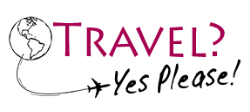Nazca Lines Flight- Flying Over Peru’s Mysterious Geoglyphs
Purchases made through links earn us a small commission, at no extra cost to you.
“Coming up on the right, whale,” one of the pilots announces over the speaker as we approach the first geoglyph on our Nazca Lines flight.
Palms sweating with excitement, I stare intently out the window, camera in hand and ready to shoot as soon as I spot the whale.
The pilot banks the plane, angling our field of view directly above the whale.
“Now! Whale!” he tells us.
Where is it? Where is it? I panic.
Then suddenly I notice it. The whale!
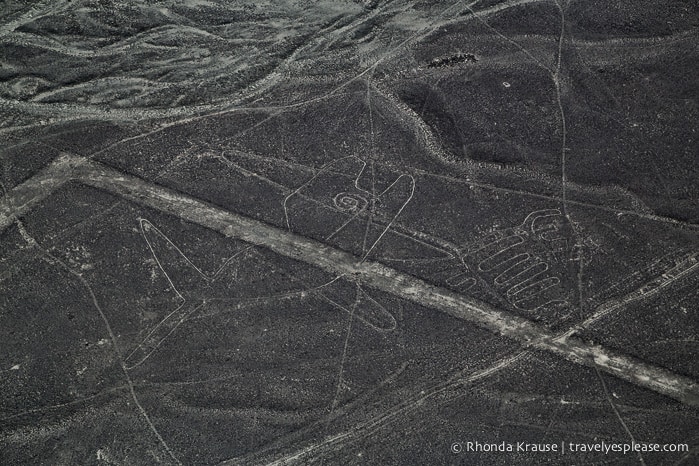
“I see it! I see it!” I shout to no one in particular, as I excitedly begin snapping pictures through the window, hoping with all my might they turn out.
Scratched into the grey, dusty desert plains are some thin lines, faintly outlining the shape of a whale.
I notice a wide pathway cutting the whale in two and other surface marks partially detracting from the geoglyph.
Still, it’s a wonder to see.
Sitting back in my chair, I catch my breath as the pilot sharply banks the plane to the left. He circles around the whale once again, giving passengers on the other side an equal opportunity to view the whale.
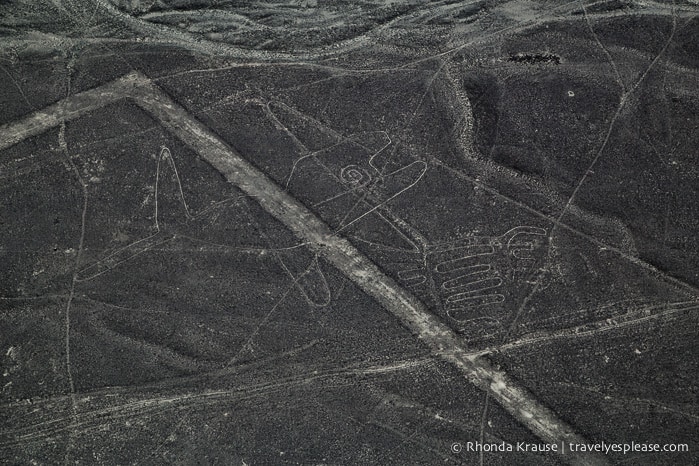
“Do you see it?” I yell across the aisle at Mike, sensing his anticipation from afar.
“There it is!” he exclaims, “I can see it!”
As the plane completes its lap around the whale, I grasp the collective thrill of everyone on board.
We just flew over a Nazca Line!
As our journey continues, so does the excitement, as flying over the Nazca Lines is no ordinary flight.
Soon I am gazing out at the astronaut, etched prominently into the side of a hill. I easily spot this one thanks to the contrast between the reddish rock of the hill and the white lines of the human-like figure.
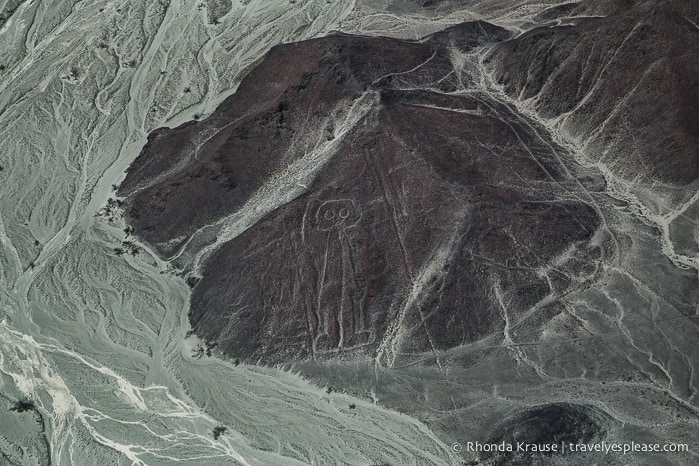
Gliding past the astronaut I begin to wonder, why did the Nazca people make these lines? What purpose did the Nazca Lines serve? Were they ancient foot race paths, offerings to the gods, astronomical alignments, or markers of underground water sources? All are possible theories. Some people even think they might have been alien runways.
Lost in contemplation, I almost miss the next geoglyph- the monkey. I spot it just as it’s slightly behind me, far enough back that I can’t capture a photo without cutting off part of its arm.
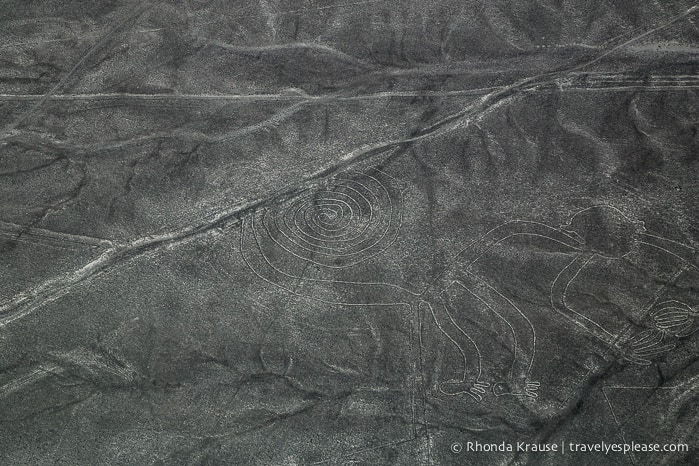
Darn it! I thought, reminding myself to stay focused on the experience. I didn’t want to miss a second of this.
After the monkey, the geoglyphs start to appear in close proximity with each other. The dog is next, swiftly followed by the spectacular hummingbird.
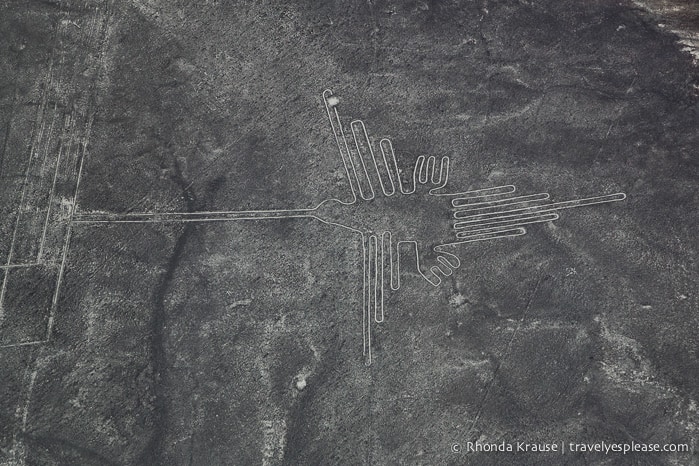
Oh, wow! I instantly decide that the hummingbird is my favourite Nazca Line so far. I admire it for every possible second before the plane turns away and heads towards the next geoglyph.
We loop around the spider, then almost immediately circle above the condor.
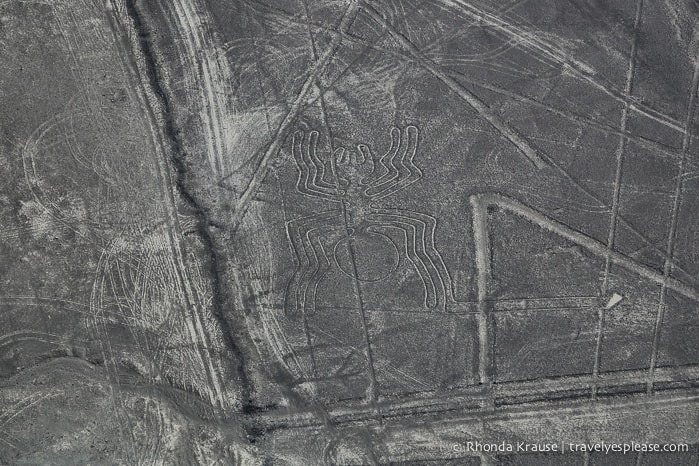
For the first time during the flight, I feel a tinge of disappointment. There are so many lines slicing through the condor that it’s hard to get a good look at it, to appreciate it as a whole.
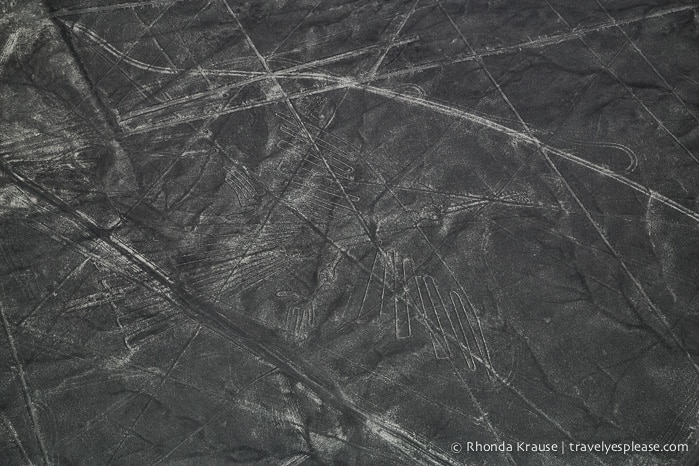
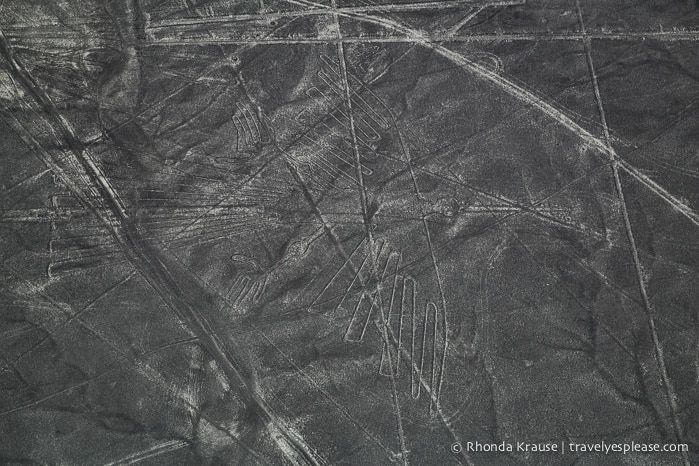
No need to dwell though, since moments later I am staring down at the heron bird, the largest geoglyph we’ve seen so far on the flight. It’s magnificent, but I’m struggling to enjoy it.
The sharp banks the pilot is doing, and the rapid succession of geoglyphs, begin to make my head spin and stomach flip. I want to put my head between my knees, like how the man sitting in front of Mike has been the entire flight, but I am determined not to miss out. We are only going to fly over a few more Nazca Lines.
Willing away my nausea, I look out at the parrot, then get a quick glimpse of the tree and hands located very close to the side of a highway.
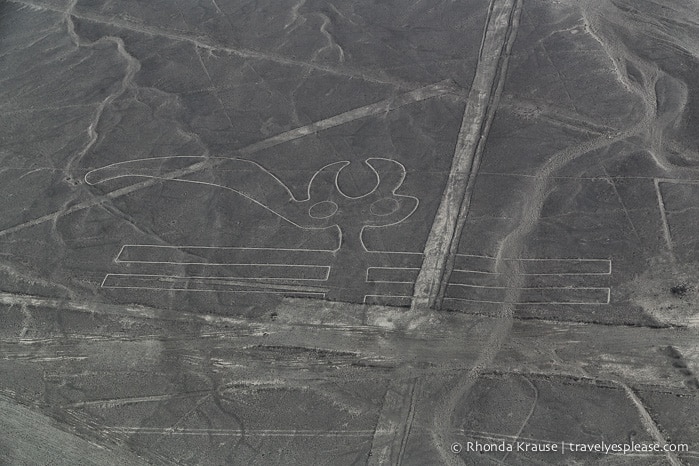
The hands are the last figure on our Nazca Lines flight. As soon as we begin the return trip over the Nazca desert, I close my eyes and lean my head against the seat in front of me.
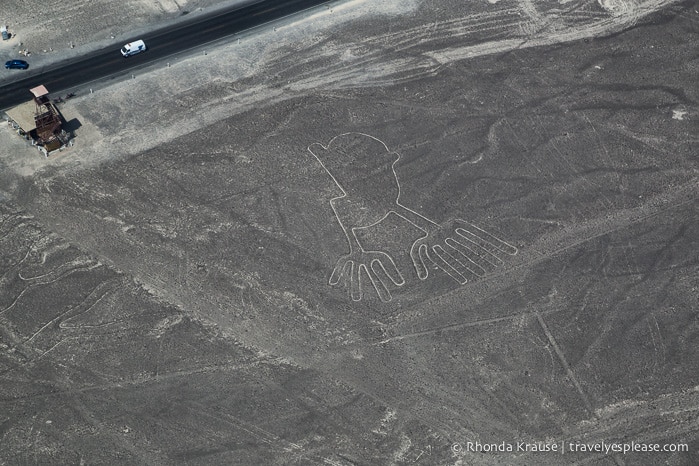
Once again, I drift into thought.
Flying over the Nazca Lines was an incredible experience, yet it went by in a blur. Moments after seeing our last Nazca Line, I was already reminiscing about what I saw, trying to burn it into memory.
It’s impressive how these astounding creations of an ancient civilization remain ingrained in the desert, thousands of years after they were scratched onto the surface, and still, they are shrouded in mystery.
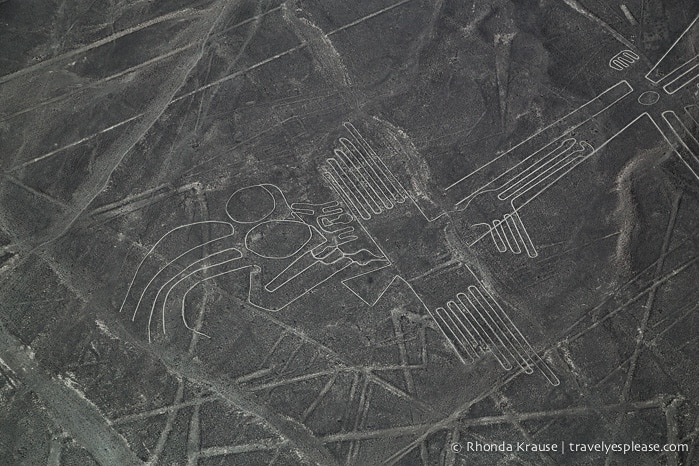
While we many never know the secrets behind the Nazca Lines, I am certain of one thing- flying over the Nazca Lines is a fascinating excursion in Peru!
Interesting Facts About the Nazca Lines
- The Nazca Lines were created between 500 B.C. and 500 A.D. by the Nazca civilization.
- There are about 800 straight lines and over 500 different figures depicting animals, plants, human beings, and geometric shapes. Most of the figures are made from a single, continuous line.
- The largest figures measure over 300 metres long.
- The Nazca Lines were made by creating shallow trenches. The dark stones covering the desert surface were removed to reveal the light coloured soil underneath.
- Some of the straight lines run several kilometers across the desert, so precise they vary by only a few degrees.
- The Nazca Lines have been naturally preserved because of the extremely dry, windless and stable climate.
- The Pan American highway cuts right through the lizard.
- The Nazca Lines were listed by UNESCO as a World Heritage Site in 1994.
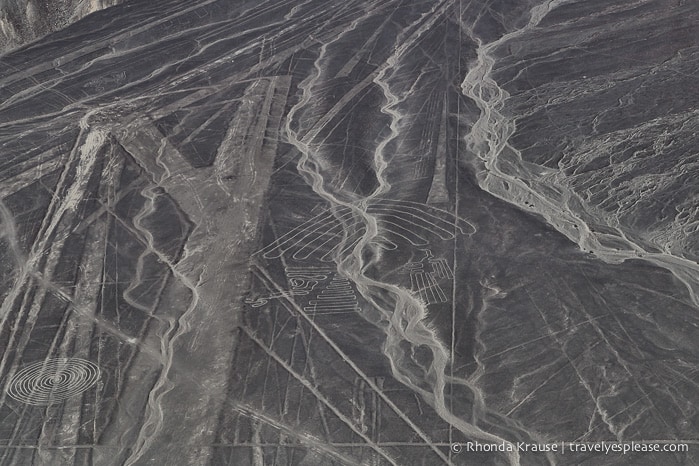
Tips for Taking a Nazca Lines Flight
Location: The Nazca Lines are located in Southern Peru, between the towns of Nazca and Palpa, about 400 km south of Lima.
Getting There: Nazca Lines flights depart from Nazca, Ica, even Pisco (closest to Lima, but will be the most expensive flight).
- We did our Nazca Lines flight from Ica since we were there sandboarding at Huacachina. We didn’t want to spend 4.5 hours of our day on a bus, so opted to pay more for the Nazca Lines flight from Ica.
Nazca Lines Flight: Our flight duration was 70 minutes (from Ica), with about 30-35 minutes over the Nazca Lines.
- Our plane was a Cessna Grand Caravan and each person had a window seat.
- Regulations require there to be a pilot and a co-pilot.
- An airport tax of $20 US must be paid in cash at the airport. You will also have to show your passport and go through security screening (which was slow and very thorough).
- If you are prone to motion sickness, take some medication in advance and don’t eat before your flight.
- No information about the Nazca Lines is given during the flight, so read about them before hand.
Safety: There have been crashes in the past, so we recommend choosing your airline/tour company based on their safety record, flight and maintenance policies, rather than price.
Nazca Line Photography Tips: To avoid window glare, put your lens directly up against the glass (or as close to the glass as possible).
- Make sure you are shooting with a very fast shutter speed to get sharp pictures without motion blur.
- Wait for the pilot to announce where the specific Nazca Line is before looking through your viewfinder. If you try and spot the geoglyphs through your camera, you may not notice them in time.
Information was updated January 2025, but can change without notice. Please confirm directly with service providers.
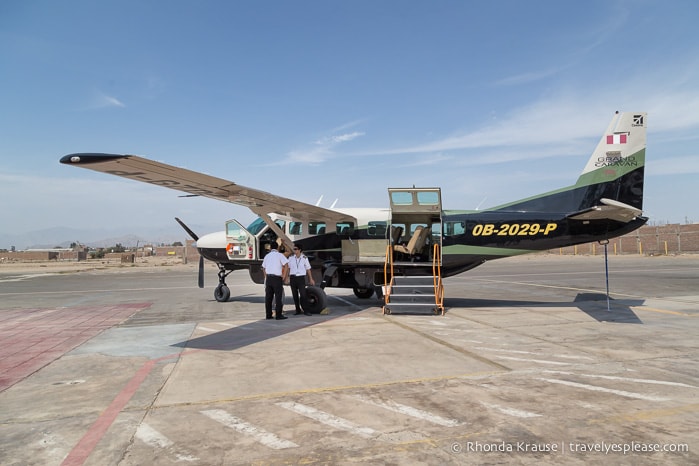
Nazca Lines Tours
Here is a reputable site where you can book a Nazca Lines tour.
Accommodations in Nazca and Ica
For your convenience, here is a list of hotels in Nazca and in Ica. Please consider booking your accommodations through the included link. It costs you nothing extra and helps support this website. Thank you!
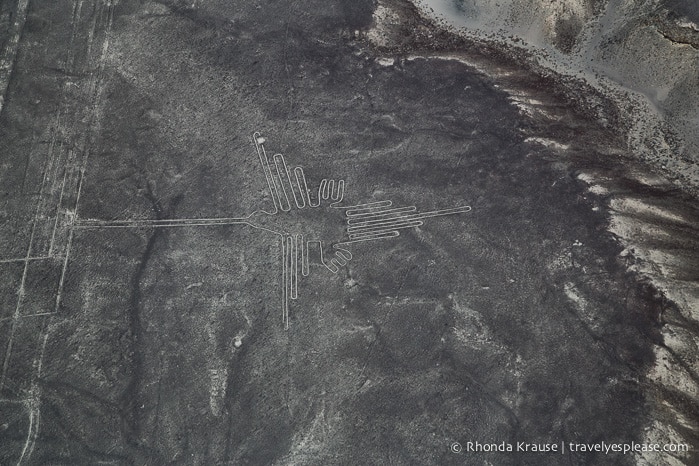
More Peru Destinations and Travel Guides
- Visiting Machu Picchu- Peru’s Hilltop Inca Citadel
- Hiking the Inca Trail- What to Expect on the 4 Day Trek to Machu Picchu
- The Pisac Ruins- Gateway to the Sacred Valley of the Incas
- Ruins Near Cusco- 7 Archaeological Sites Worth Visiting
